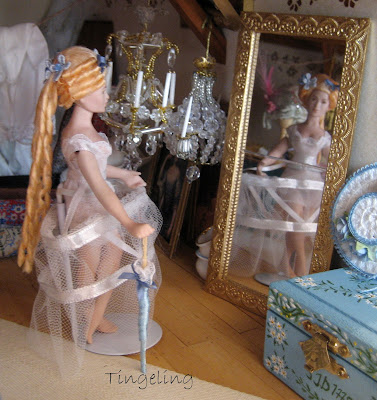Kartanon kahdestoista ja viimeinen valmistunut huone on vintti. Vintillä tai muussa lämmittämättömässä huoneessa yleensä säilytettiin vaatteita. Täällä niitä myös kuivatetaan sateisella säällä. Vintti toimii myös erilaisten pukeutumisvälineiden säilytyspaikkana ja myös kesäisin pukeutumishuoneena.
The last room of the 12 rooms of the manor is the attic. The clothes were stored at the attic or in another unwarmed room. They are also dried here during rainy weather. In summer the attic also funtions as a dressing room.
Nukkeneito nimeltä Narcissa valmistautuu tässä illalliselle. Puku odottaa tuolilla. Hänellä on 1700-luvun alushame, jota tarvitiin kannattelemaan valtaisan leveitä hameita. Alushame oli tehty valaanluisen kehikon ympärille ja se piti ylhäällä hameen isoja koristeellisia sivuja samalla pitäen etuosan ja takaosan litteänä. Pukemattoman nuken on tehnyt nukketaiteilija Taru.
The lady, named Narcissa, is preparing for a dinner. The gown is waiting on the chair. She has a pannier hoop, a 18th century undergarment which was an essential prerequisite in the support of the exaggerared style for the day - the pannier gown. The aim of the undergarment was to support large decorative sides to an extra ordinary wide skirt whilst retaining a flat front and back. The undressed doll is made by doll artist Taru.
Monenlaista tavaraa säilytetään vintillä, mm. tuohisia koreja. Tuohta käytettiin yleisesti kenkien, saappaiden, reppujen ja korien materiaalina. Kenkinä se ei ollut kovin kestävää, mutta kätevä tekijä valmisti uudet kengät tunnissa. Tuolilla istuu posliininen nukke, jonka vintillä leikkivä lapsi on unohtanut jälkeensä. Nukke on ostettu Tukholman miniatyyrimarkkinoita muutama vuosi sitten.
Many items are stored in the attic, among others baskets made of birch bark. Birch bark was used as a material for shoes, boots, backpacks and baskets. For shoes the material was not very lasting but a handy maker did new shoes in an hour. On a chair sits a procelain doll, left behind of some child of the manor. The undressed doll was bought from miniature fair from Stockholm some years ago.
Jokaisella arvonsa tuntevalla kartanolla on omat kummituksensa. Fjärilsgårdilla on kolme. Yksi kummituksista on vuosikymmeniä sitten elänyt neito, joka heittäytyi epätoivoissaan parvekkeelta, kun häntä oltiin pakottamassa naimisiin väärän kosijan kanssa. Mistä tietekin aiheutui, että oikea kosija hukuttautui kartanon lampeen. Vintin lisäksi heidät nähdään usein yöaikaan kävelemässä yhdessä lammen rannalla kartanon puutarhassa. Kolmannen kummituksen tarinaa ei tunne oikein kukaan, mutta kartanon kummituksista se on kaikkien levottomin - ehkä se on yksinäinen.
Every self-respecting manor has its own chosts. Fjärilsgårds manor has three of them. One of them is a lady lived decennies ago who was about to be forced to marry a suitor who she did not love and she dived into death from a balcony. The right suitor she loved drowned himself to a pond nearby the manor. Besides the attic the ghost couple is seen during the night time walking by the pond in the garden. No one knows the story of the third ghost but it is the most restless of them - perhaps because it is lonely.
Puku valmiina puettavaksi.
The dress ready to put on.
Vaatteet säilytettiin yleensä arkuissa. Jokaisella oli oma arkkunsa ja siinä nimikirjaimet. Koristeellisin ja arvokkain oli ns. morsiuskirstu, johon morsian keräsi tykötarpeita tuleevaa omaa kotia varten. Sinne kerättiin vaatteiden lisäksi mm. lakanoita ja pöytäliinoja. Myös hopeita ja muita arvotavaroita voitiin säilyttää arkuissa.
Useally the clothes were stored in big chests with the initials of the owner. The most decorative and valuable was the bride chest where the bride collected items for her own home: besides clothes also sheets, table cloths etc. Also silver and other valuable stuff was stored in chests.
Vakoissa myös säilytettiin kaikenlaisia tavaroita. Niitä käytettiin myös tavaroiden kuljettamiseen. Hienoimpia olivat ns. kirkkovakat, joissa kuljetettiin raamattua ja päähuivia. Maaseudulla yleensä kierteli koristemaalareita, jotka maalasivat vakkoja ja muita huonekaluja. Sanonta "vakka kantensa valitsee" tulee siitä, että vakkaa ja kantta oli yleensä hyvin vaikea taivuttaa puusta samankokoisiksi.
So called "vakka", a small round or oval box, was also a storing item. They were used also to carry things. The most beautiful were chruch vakkas which were used to store a bible and a head skarf during the church visits on Sundays. On countryside there were travelling decorative painters who painted vakkas and furniture. An old saying " a vakka chooses its lid" meaning along the lines "like minded people fit together" originates the fact that it was very difficult to bend from wood a fitting lid and a vakka.
Vaatteita ja laukkuja.
Clothes and bags.
Peruukkeja suuriin tanssiaisiin. Kartiota, johon on tehty silmänreiät, käytettiin levitettäessä peruukkiin puuteria.
Wigs for great balls. The cone with eye holes was used when powdering the wig.

Vanhat kristallikruunut ja taulut säilytetään myös vintillä.
Old chandeliers and paintings are stored in the attic as well.





























